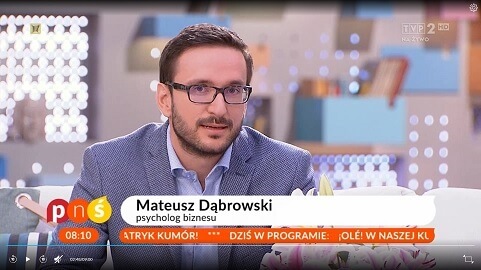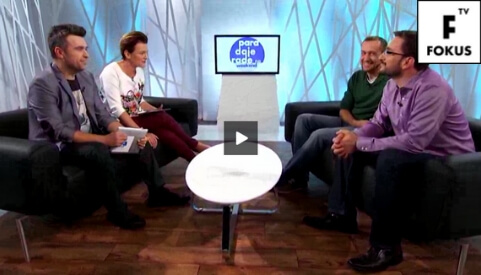Złap rabaty na szkolenia w lipcu i sierpniu. Latem mniej nawet do -290 zł netto za uczestnika Sprawdź szkolenia w promocji
Public speaking and presentation training
Training versions:
stationary | open: Warsaw
Do you want your public speeches to remain in the audience's memory for a long time?
Do your body and voice show stage fright and stress?
Do you want to free yourself and feel natural body language?
Is the goal of your presentation to convince the audience and encourage them to take action?
You are in the right place - you will receive from us 36 public speaking techniques, thanks to which you will build authority and be remembered as the most interesting and effective speaker!
or
Training effects
Our public speaking and presentation training is different from the rest of the training on this topic -
Because we have certain assumptions that translate into how we train:
- Body language during the speech must be yours - true - you must feel good in your body, you have your natural and beautiful expression, which has been suppressed by stress. We use acting techniques, but to free you from artificiality, not to teach you artificial gestures and gestures that create a desired public media image - if you need it, training with media presenters will be better for you. During our public speaking training, you will discover your natural and comfortable gestures, postures, gestures and facial expressions.
- We transform stress before a public speaking into self-confidence and dynamism during the training - we will not teach you how to control stress during a presentation, we will teach you how to use stress to make your speech more dynamic. And this, combined with natural body language, will give you extraordinary self-confidence and build your authority!
- Your public speaking has to be convincing - so we will not teach you during the entire training how to present yourself. Half of the training is dedicated to ensuring that your presentations end with the words of your audience: YES, I AGREE WITH YOU, I TAKE IT, I SIGN, YOU HAVE THE GREEN LIGHT, I WANT MORE!!! If you only want to provide information and objective analyses, where there is no room for your narrative, recommendation, point of view, and you only care about correct body language and speaking, self-presentation training will be better for you.
- A public speech with a presentation should be intriguing - because only then will you gain attention for longer than until the next text message is sent to the recipient's phone. More and more people are trained and able to make good presentations, so yours should be unique and memorable. Curiosity is a vehicle for remembering the content of your presentation, and the content will be persuasive not only during and immediately after, but for a long time...
- Your voice has more importance - and possibilities than you think - whoever reads bedtime stories to children or remembers their parent knows that reading can be done to put them to sleep or to stimulate them. The same applies to presentations and speeches. You can fall in love with both the voice and the appearance. Yes, everyone doesn't like to hear their own voice at first. At the beginning, i.e. before this training ;)
- You have an influence on the audience's behavior and perception - not only through content and body language, but also through interventions that stimulate attention and diplomatically determine behavior in a "good tone". And at an advanced level - they even build your authority and respect among your audience. So we will teach you how to "lead" during the training. So that others want to follow your narrative!
They have already attended our training
Regardless of what kind of marketing a training company does - the number and content of opinions and their credibility absolutely verify the quality of the training! Read the opinions of our participants about public speaking and presentation training and other training - they are the best proof of what you can expect. We have plenty of them (and that says something...), signed with their full name and company name.
Energetic, exhausting, liberating.
Mega workout! Learning without rest! Every minute spent in a valuable way. A trainer who teaches, praises and corrects – discovers your potential! Thank you!
We conducted training for:
Who is this training for?
For you if:
- You will be performing and presenting to the following audiences:
- management board, managers
- project team members or co-workers
- hundreds of participants in conferences, lectures and seminars
- in front of the client in an intimate group
- camera
- you are a supervisor or will manage a team - you will speak to the team
- you are preparing to become a trainer, or you are a self-taught trainer.
- The purpose of your public speaking is:
- motivational speech
- PowerPoint's presentation,
- analysis of results in Excel
- analysis of risks and problems
- recommendation of ideas
- presentation of new information
- teaching and developing others
Read the program or check other training options
Two-day training program:
Public speaking and business presentations
All presentations and speeches by participants (7-8 in total) are recorded on camera, including feedback on areas for development and strengths given by the trainer and selected Participants. The participant receives his recordings to be able to further improve his skills after the training.
1. How to turn stress and stage fright into energy and confidence during public speaking?
Is stress your greatest ally? YES, if you know how to use it for speeches and presentations:
- Techniques for reducing stress from the reptilian and mammalian brain.
- Techniques for releasing energy stress for dynamic expression of the body and sound.
- Techniques for developing a sense of self-confidence.
Say goodbye to: trembling voice, hands, rashes on the neckline and decreased intellectual performance!
2. How to interest the audience during a speech and presentation?
From your first words, even before you say anything, the audience watches you perform with a sparkle in their eyes and listens with full attention to what you say.
Get ready for this - it's very pleasant, appreciative to see such an interested audience.
It's addictive - you really want to give more and more presentations and perform in public :)!
- Techniques for building interest, tension, dialogue and amusement:
- Sinusoid™ structure - keep the audience in suspense throughout the entire presentation!
- Shark™ structure - you will make the recipients want to swallow your every word and ask for more!
- Gadgets - you will disturb everyone from their thought patterns and become memorable!
- Supporting tools - slides, flipchart - they are also powerful tools for intrigue!
- The rhetorical devices that we all use unconsciously and consciously apply are powerful catalysts for attention:
- procrastination,
- antithesis,
- pauses,
- repeat,
- metaphor,
- anecdote,
- questions and rhetorical questions.
3. Body language during public speaking - yours is true, energetic, confident, natural and composed
- Sight and eye contact - you will get several techniques that will help your eyes know what to do;) during the following public speeches:
- at conferences and events when the audience is tens/hundreds of people
- at intimate performances for several people
- during interviews/participation in TV programs
- when conducting meetings/presentations via videoconferencing or a mixed system - some people are in the room, some are connected via videoconference
- Body language - we will teach you to feel like a fish in your body during public speaking! We will match the following that best suit you and support your authority:
- facial expressions (your best facial expressions),
- posture (including leg positions, hip position),
- static gestures (including boats, turrets, macho, etc.),
- gesturing (which adds dynamics to your speech),
- gesturing with a microphone, presenter
- gesturing with a pad/board.
- Moving in front of the audience during a speech - you will gain knowledge and practice:
- proxemics - what distances to keep from the audience, how and where to walk on the stage during a speech,
- where and how to sit (without any obstacles, at the table, on the sofa/armchair - especially while watching TV)
- how to use the tools - a projector, a lectern, a flipchart.
- Elements of savoir-vivre in presentation - what should and should not be done.
4. Your Voice - strong, colorful and dynamic during public speaking!
- Your voice will gain strength and color thanks to simple exercises to work on voice emission:
- diction,
- pauses,
- breathing,
- and modulation with the following elements:
- volume,
- speed,
- intonation,
- Timbre.
5. How to convince people about your ideas and recommendations in a public speech
- What determines the effectiveness of your message - the psychology of persuasion in public speaking
- Persuasive public speaking structures and scripts used by top speakers (including Steve Jobs, Anthony Robbins, Brian Tracy, Barrack Obama)
- Designing the content structure - what to do to make the message focused, understandable and effective:
- Structure of Persuasion™ – how to arouse and maintain the dynamics of a public speech and convince the recipient to the desired thoughts and decisions .
- Shark Model™ – how to win over the recipient and leave our public speech in their mind for a long time .
- Structure patterns, functions and proportions of content: introduction, development and conclusion of the presentation.
- Time management - time proportions for speech and presentation elements.
6. How to deal with undesirable audience behavior during a speech?
- Audience uninterested, bored - techniques to stimulate.
- How to cope when something unexpected happens?
- How to react when we don't know the answer to a question?
- A shy, taciturn recipient - techniques for opening up.
- A talkative, clowning participant - techniques to calm down.
7. How to dynamically conduct online presentations?
We complete this module during individual training, which is included in the training package - see the Benefits section
- Body language during online presentations
- How to keep the attention of participants in an online presentation?
- Effective techniques for stimulating interest and maintaining attention during online presentations
- How to speak with passion and energy and ensure an emotional message?
- Completing an online presentation – or how to ensure effectiveness
8. We optimize your public speaking during training
- We will tailor your entire workshop related to the body, techniques and external tools when:
- Your public speaking concerns:
- risks and problems,
- recommendations and ideas,
- products,
- numbers (and you love Excel ;)),
- new information,
- development of recipients' competences.
- you will be presenting before:
- management board, managers,
- project team members or collaborators,
- participants of conferences, lectures, seminars,
- in front of the client in an intimate group,
- camera.
- Your public speaking concerns:
- Individual development plan recorded for you by the trainer:
- What to strengthen
- What to avoid
- What to work on firstt
Come learn techniques that will change the quality of your public speaking and presentations!
6 training benefits that help us beat the competition

The trainer will ask about your needs and propose the optimal
program FREE
You can talk to a trainer today about your concerns and needs regarding public speaking and presentation training and make sure they are met. And they will be fulfilled, even if they go beyond the training formula, because only with us "program" means more than just training:

The trainer will take care of you during EXTRA individual training
FREE
When you want to tackle a challenge that goes beyond the training program, but related to the topic of presentations and public speaking, or prepare for an important and difficult presentation, practice and make sure that you optimally apply the learned techniques during the speech - you have 90 minutes one-on-one with the trainer , within one year of training. Apart from that:

The trainer supports you by phone without any hours limit FREE
After all, after the training, we start to see more, so new questions arise. And a helping hand is useful to combine the wealth of knowledge and techniques acquired from our presentation and speaking training with your life. Additionally:

Access to the training platform FREE
After completing the public speaking and presentation training, each participant receives unlimited time access to the 4GROW online platform, where he or she can preview training materials, use exercises and tools, read the list of recommended books and use the forum.

Your training will be 100% FREE
Because we do not cancel training. For each date there is information about whether the training date is already guaranteed. Our training dates are covered by a guarantee - depending on the training topic - from 3, 2 or even 1 participant!

Group training after training FREE
Every few months, we organize 2-hour group trainings, during which you have the opportunity to further practice in front of the audience and receive feedback from the trainer and participants - thanks to this, you can further develop your skills and refresh your techniques!
See for yourself how pleasant and effective development can be!
Coach

Mateusz Dąbrowski
I have been giving public speeches and presentations for over a dozen years: as a speaker for hundreds of people at conferences (including Automotive Fairs) and seminars (including Puls Biznesu), as a lecturer at universities (including topic of Charisma and Conflict Management at Adam Mickiewicz University), as a trainer in front of training participants, as a consultant and salesperson in front of clients and finally - as a manager in front of the team.
I comment as an expert - business psychologist in the media: before camera: Polsat, TVP2, TTV; in front of the microphone: Polish Radio Program 3, Polish Radio Program 4; paper: HR Standard, Newsweek Psychologia and many others.
Since 2010, I have been the president of 4GROW, successfully introducing the brand to the leader among training companies. Previously, I had the pleasure of working in sales and HR, in Polish and international companies and in corporations. I am also the president of the Association of Business Negotiators. I am a personality psychologist by education, a business psychologist by experience, and a methodologist and strategist by heart - I love creating brands, products, training programs, psychological theories, techniques, tools and strategies. Likewise, I have created many techniques, including techniques for effective public speaking. I am also a certified trainer, ICC coach and an accredited Insights Discovery® consultant.
I am an experienced business practitioner and trainer in the field of public speaking and business presentations, and my extensive experience is the result of a twenty-year career in managerial positions in various companies, both domestic and international. Over the years, I have worked in various industries, such as consulting (the big four), FMCG, digital telephony and media. In my career, I had the pleasure of managing the internal audit department and the purchasing and business controlling department as a director.
However, it was as a business coach that I found my true calling. I love public speaking and conducting training and workshops. I believe that transferring knowledge and skills is the fulfillment of my life mission and the use of all my talents.
My training focuses mainly on self-presentation, communication and public speaking, but also on building a personal brand. I specialize in managerial training, which is addressed to managers at all levels of management.
I believe in the potential of every person, and I am convinced that everyone can achieve what they dream of with a bit of willingness, hard work and perseverance.
Training methodology
W naszych szkoleniach dostajesz właśnie w takich proporcjach:


Techniki i narzędzia konkretne strategie działania adekwatne do sytuacji i optymalne narzędzia (np. formularze, scenariusze rozmów, matryce, ściągi) – gotowce, które wiesz jak wykorzystać na co dzień
Warsztat dzięki ćwiczeniom grupowym, grom, pracy w parach, na gorącym krześle, prowokacjom, wdrażasz nowe techniki i narzędzia, doświadczasz omawianych mechanizmów na sobie także w zaskakujących eksperymentach
Wiedza niezbędne informacje, teorie przełamujące schematy i mity, badania i odkrycia z różnych dziedzin: psychologii, neurobiologii, coachingu, NLP
- Training in public speaking and business presentations is conducted in workshops - participants practice the techniques and tools learned in a very diverse way.
- Each participant has approximately 7–8 appearances in front of the camera and is recorded, and after the training they receive their recordings.
- Trainer during the training 2 times plays the participants their recordings showing their speeches before applying specific techniques and showing and discussing how much progress they have made (and the progress is great;))
- Everyone receives training materials, exercises and tools (forms, cheat sheets, planners, etc.).
- After the training, the participant receives access to the 4GROW training platform, where:
- all training materials are embedded and
- is a forum for written communication with the trainer and training participants on this topic, enabling asking questions and exchanging experiences.
Your comfort in comfortable armchairs!
and max 10 people in the room
See for yourself our quality -
Why do participants value our training?
Public speaking and presentation training dates
| TERMINY | WARIANT SZKOLENIA | LOKALIZACJA | |||
|---|---|---|---|---|---|
| 2025-07-24 - 2025-07-25 |
|
Warszawa
|
Zarezerwuj | ||
| 2025-09-04 - 2025-09-05 |
|
Warszawa
|
Zarezerwuj | ||
| Do uzgodnienia |
|
Mix: Online lub dowolne miasto | Zapytaj | ||
| 2025-09-30 - 2025-10-01 |
|
Warszawa
|
Zarezerwuj |
Article
Public speaking - presentation training, public speaking training Warsaw
Have you ever felt like the ground suddenly fell out from under your feet and your mind went blank when you had to express your opinion on a forum or speak in a group discussion? Or maybe during a conversation with your boss? Are you generally afraid of your public speaking? The training will show you that there is no reason to worry. Regardless of gender, age or position, stage fright can affect anyone. This is a type of anxiety felt not only in stressful situations. The fear of not presenting the image of ourselves that we want others to see. Public speaking and business presentations training will make you realize that it is not the audience that is the source of your stage fright, but you yourself. The purpose of public speaking and business presentation training is to make you realize that success depends only on you, and only you can influence your presentations. That's what training is for, after all, few people are born as rousing speakers, but anyone can learn to speak in a way that is interesting and memorable!
Contents:
- Public speaking
- Public speaking – training
- Public speaking techniques for stress, body language and voice
- Public speaking techniques: persuasion
- Public speaking techniques: making things interesting
- Public speaking techniques: dealing with difficult audience behavior
- Public speaking – stress
- How to prepare for a public speaking
- Public speaking book
- Public speaking course
- PowerPoint's presentation and public speaking
Public speaking
Although the word "public" is associated with many people, we talk about public speaking with two people, when our goal is to present some content to them - that is, to convey something to our recipients. Most often, it will be verbal content, i.e. we will talk, but it also happens that the content is only expressed through body language, e.g. models appear in public by speaking with their bodies - movements, facial expressions.
So what is the difference between public speaking and a conversation among, for example, managers? We talk about public speaking when someone has to convey some content publicly, and therefore we have a "communicator" - a speaker, a presenter and an "audience", where the speaker has a goal and effect to achieve with his speech. So it is not a casual conversation or dialogue - it is planned and structured content intended to produce a predetermined effect.
Public speaking – training
It is fair to wonder whether public speaking training is warranted. You are probably wondering whether practicing alone in front of the mirror or repeating the prepared content while walking around your room is enough. The answer will probably surprise you: training will not give you what your own practice will give you, and vice versa - your own practice will not give you what the training will give you.
Public speaking and presentations are unusual, non-standard situations in our lives, so they require a completely new approach and new skills to be effective and derive satisfaction from them. To make this happen, you need something that your own training cannot give you:
- Learn to turn stress into positive energy and self-confidence
- Unlearn bad habits in body language and sound
- Thanks to the two previous points - unleash natural, expressive body language and dynamic sound modulation
- Learn to design content structure and narratives aimed at convincing the recipient of your own point of view
- Learn to intrigue and arouse interest through content/substantive methods and the form of narration
- Learn to deal constructively with recipients' reactions, e.g. difficult questions, malicious comments, lack of attention, boredom, antics, etc.
Unfortunately, these skills necessary for public speaking and presentations are not taught in our educational system, nor do we learn them on the job, because public speaking is a relatively rare situation in which the speaker is alone on the "stage" and concentrates on his message, and doesn't whisper in our ears a lesson on "how to perform well"...
So, during the "Public Speaking and Presentations" training, you will get new techniques that you will practice several times at best, and in order to feel like a fish out of water with these techniques, you need to practice them a dozen times. So your own training is necessary after the training. On the other hand, your own training only practices what you already know and know, so you don't practice new ways, you just consolidate the old ones, and this can be harmful to you if you have incorrect habits - which, unfortunately, is most often the case.
Where do these incorrect habits mentioned above come from? What new things can you learn – what techniques?
Public speaking techniques for stress, body language and voice
Well, under the influence of stress and tension, our body begins to behave unnaturally - just as during an ordinary conversation we do not think about what to do with our hands and how to gesture, while during a public speaking we try to master:
- stress in the hands - we deprive ourselves of natural gestures, the hands are stiff, clenched in an artificial gesture
- stress in the voice - our voice begins to tremble
- stress in the torso, neck, face - flushing appears, the neck trembles
- stress in the legs and hips - uncoordinated movements begin - legs dancing, hips swaying, legs intertwining or nervous walking resembling a clock pendulum or a circling helicopter
Public speaking training will equip you with techniques for reducing stress and building self-confidence, as well as channeling stress into positive energy in expression - body and voice. And for this to happen, during the training you will free yourself from old patterns and habits, the so-called weeds in body language mentioned above and in sound such as:
- paralinguistic sounds, e.g. "yyyyyyyyyy"
- stuttering
- slips of the tongue
- monotonous modulation, i.e. its lack: uniformly speaking too fast, or speaking too quietly, or flat intonation and uniform timbre/timbre
paving the way for natural, expressive gesture techniques and a strong, dynamic voice with rich modulation.
Public speaking techniques: persuasion
Since we do not learn in life, apart from training, techniques of persuasion during presentations or speeches, most often when preparing content we simply gather everything we know about a given topic and, unaware of the importance of the order of the elements of our content, we arrange the narrative intuitively "somehow", at the same time feeling uncertain how it will be picked up. During the public speaking and presentation training, you will learn content design and narrative techniques that will make your content persuasive and your presentation effective.
Public speaking techniques: making things interesting
Nobody teaches us how to tell an interesting story, so very often, even in our private life, at a party, when we want to tell a story, we wonder whether to speak up - whether what we want to say will be interesting, funny... let alone in front of an audience during a speech and presentation, where they often weigh our professional fate. Therefore, during the public speaking training, you will learn and practice substantive techniques and the way of building a narrative that cause curiosity, attentiveness and positive tension that enhances concentration - just like during the best thriller, when you are absorbed in the narrative to such an extent that you do not want to go to the toilet to avoid lose not a second!
Public speaking techniques: dealing with difficult audience behavior
And finally - our natural reactions to difficult questions or malicious comments or lack of involvement on the part of the recipient are conflict-generating - we either respond with malice or "extinguish" the "opponent" - because after all, he is our enemy - so it seems to us subconsciously, and we deal with those who talk or do not pay attention. in a teacher's way - directive... Unfortunately, the effect of such interventions is that at best we "lose" the participant, in the worst case, and unfortunately the most common one, we gain an enemy who will look for opportunities to depreciate us even more. Therefore, training in presentations and public speaking will equip you with techniques for conciliatory, partner-like dealing with participants who are bored, inattentive, laughing, malicious, smart-ass and shy.
Public speaking – stress
Where does stress come from when we think about our planned speech and during our public speaking? Stress in the context of speeches is governed by two mechanisms:
- Stress caused by fear of being assessed – both by yourself and the audience. This mechanism is governed by the neocortex, the newest part of the brain, the so-called mammalian brain, responsible for thinking. Well, we think, we imagine that we will make a mistake, that we will say or do something "wrong" - that is, we create worst-case scenarios for which our body prepares by increasing the tension in the body - that is, stress.
- Stress caused by a subconscious threat - this mechanism is governed by the so-called the reptilian brain, i.e. the evolutionarily old brain responsible for automatic reactions to life-threatening situations: escape, attack or "freeze". And when we stand during a presentation or public speaking, as one person in front of several, several dozen or several hundred people, our reptilian brain recognizes this situation as a life-threatening situation - after all, there are many against one, therefore it increases the level of tension in the body, i.e. stress, to prepare the body to defend life.
Fortunately, there are ways to deal with both brains that you will learn during the Public Speaking and Business Presentations training, thanks to which stress will give you positive energy and strength instead of paralyzing you!
How to prepare for a public speaking
As I mentioned earlier, nothing can replace your preparation and training, training is supposed to give you techniques and momentum, and before every speech, everyone, even the best speaker, prepares. So before public speaking and presentation:
- Define the goal - what do you want to achieve with your speech and presentation?
The goal will determine the components of the content of your presentation and can radically change the content and your narrative. - Prepare arguments and counter-arguments - after all, most of us want to convince our recipients of something - an idea, an idea, a solution, a decision. If you prepare counter-arguments well and find your own arguments for them, there is a chance that you will take the weapon out of your audience's hand. You must remember, however, that arguments are not everything - to convince the recipient to make a decision or even change behavior or take a specific action - in most cases it is necessary to use an appropriate content structure, based on the psychology of influencing (and it has nothing to do with the rules of influencing). Cialdini). You will receive such structures during our Public Speaking and Business Presentations training.
- Replace negative fears with positive visualization – what percentage of your fears come true? Insignificant. So if you have to live a fiction before public speaking, maybe it's better to live a positive fiction? Start imagining how great your presentation is, how you speak fluently, see how the recipients are sitting attentively and with a slight smile of curiosity looking at you... Feel the strength in your body, the energy coming out of your colorful, dynamic voice. Feel the smile on your face, your eyes shining - see yourself from the perspective of the recipient's chair - it's so nice to see!
- And if this doesn't help you and you are still stressed - sign up for training in public speaking and business presentations, because most likely you simply recognize too well that public speaking and presentations are an area in which, without good habits and patterns, knowledge and skills - you need support. And that's OK - remember, no one taught us public speaking, so it's completely normal that you feel stressed, your speech is uninteresting and not very dynamic - because even people from the highest positions of presidents, management board members or directors struggle with such problems!
Public speaking book
If you don't have the budget for public speaking training - a book is always better than nothing, although you have to choose the book very carefully, because I assume that you will buy one and you may be discouraged if you do not find solutions to your problems in it. Please note that the area of body language, sound and voice is an area that requires corrective experience - knowledge is a negligible element of success here. The greatest area in which knowledge has a powerful impact on your change is the area of persuasion and interest - there is a lot of psychology that needs to be understood in order to skillfully persuade and interest during a public speaking. Of course, because this is a difficult area, knowledge alone is not everything - you will need a mentor who will check how you implement this knowledge in your presentations, i.e. how correctly you use persuasion structures and forms, as well as methods of interest - and here again, speech training public is irreplaceable!
Public speaking course
An online course is a very good idea to equip yourself with knowledge of public speaking techniques, and it will be easier to acquire this knowledge in the course than in a book, because we will be able to look and observe immediately how the trainer presents the techniques with his body language or voice.
However, we must always remember that public speaking is an area in which the main importance is exercise and training in acquired techniques, because our old habits manifest themselves most strongly under stress, in which we lose a significant part of our conscious control over our behavior in public speaking. Therefore, the ideal solution if you want to reduce the budget or duration of training is a combination: a book or online course on public speaking + public speaking training during training, under the supervision of a mentor. With us, such a combination will soon be possible - an online public speaking course is in preparation, and advanced training can be found in the training program options!
Powerpoint presentation and public speaking
Presentation training, understood as learning a program for presenting, is a very valuable addition to your public speaking skills! Most people who have not been trained in PowerPoint presentations treat slides as prompters - they cram everything they need to say onto them so as not to forget it. The effect of this is that the recipient reads instead of listening to you and is unable to focus well on either your public speech or your PowerPoint presentation. PowerPoint gives you powerful opportunities to enrich your message with images, movement, colors, transitions and animations - and this is another trap - most people overuse these functions, which means that the recipient of your speech is distracted by visual effects instead of focusing on understanding and absorbing the content. PowerPoint is also your time for preparing a presentation - it has many functions that significantly shorten this time, and most people do not know these functions - e.g. patterns and layouts, SmartArt and other "buttons" that can be used to do something automatically. Do you want to speed up the creation of PowerPoint presentations and reinforce your message with your presentation? Sign up for our PowerPoint presentation training!
Start achieving quick results!















